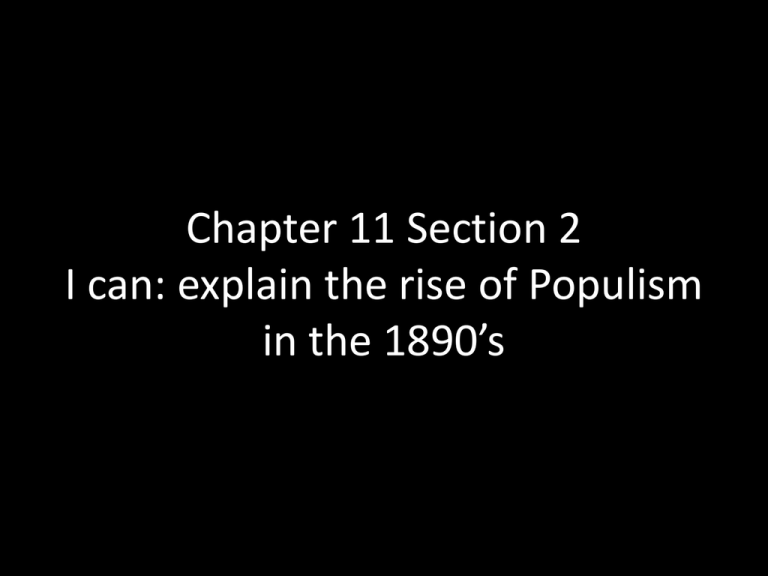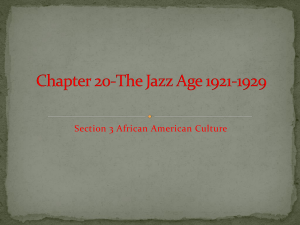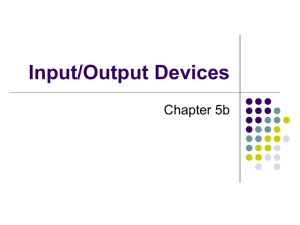Chapter 11 Section 2-3
advertisement

Chapter 11 Section 2 I can: explain the rise of Populism in the 1890’s Guide to Reading Main Idea In the 1890s an independent political movement called populism emerged to challenge the two major parties. Key Terms and Names • populism • • • • • greenback inflation deflation Grange cooperative • • • • • People’s Party graduated income tax goldbug silverite William Jennings Bryan Click the mouse button or press the Space Bar to display the information. Click the Speaker button to listen to the audio again. Unrest in Rural America • A political movement called Populism emerged to increase the political power of farmers and to work for legislation for farmers’ interests. • The nation’s money supply concerned farmers. • To help finance the Union in the Civil War, the government issued millions of dollars in greenbacks (pages 372–374) Click the mouse button or press the Space Bar to display the information. Unrest in Rural America (cont.) • This rapid increase in the money supply without a rapid increase in goods for sale caused inflation–a decline in the value of money. • The prices of goods greatly increased. • To get inflation under control, the federal government stopped printing greenbacks and started paying off bonds. (pages 372–374) Click the mouse button or press the Space Bar to display the information. Unrest in Rural America (cont.) • This led to deflation–or an increase in the value of money and a decrease in the general level of prices. • Deflation forced most farmers to borrow money to plant their crops. • The short supply of money caused an increase in interest rates that the farmers owed. (pages 372–374) Click the mouse button or press the Space Bar to display the information. Unrest in Rural America (cont.) • Some farmers wanted more greenbacks printed to expand the money supply. • Others wanted the government to mint silver coins. • The Grange was a national farm organization founded for social and educational purposes. • The Grange changed its focus to respond to the plight of farmers. (pages 372–374) Click the mouse button or press the Space Bar to display the information. Unrest in Rural America (cont.) • Grangers put their money together and created cooperatives–marketing organizations that worked to help its members. • The cooperatives pooled members’ crops and held them off the market to force the prices to rise. • Cooperatives could negotiate better shipping rates from railroads. (pages 372–374) Click the mouse button or press the Space Bar to display the information. Unrest in Rural America (cont.) • However, the Grange was unable to improve the economic conditions of farmers. (pages 372–374) Click the mouse button or press the Space Bar to display the information. Unrest in Rural America (cont.) How did the Grange try to help farmers? Some Grangers pressured state legislatures to regulate railroad and warehouse rates. Others joined the Independent National Party, or Greenback Party, to pressure the government into printing more greenbacks to increase the money supply. Grangers also formed cooperatives to help farmers market their crops for higher prices and negotiate better shipping rates. (pages 372–374) Click the mouse button or press the Space Bar to display the answer. The Farmers’ Alliance • The Farmers’ Alliance was formed in 1877. • By 1890 it had between 1.5 and 3 million members with strength in the South and on the Great Plains. • The Alliance organized large cooperatives called exchanges. • These exchanges mostly failed. (pages 374–375) Click the mouse button or press the Space Bar to display the information. The Farmers’ Alliance (cont.) • Many exchanges overextended themselves by loaning too much money at low interest rates that were not repaid. • Wholesalers, manufacturers, railroads, and bankers discriminated against the exchanges. • The exchanges were too small to make an affect. (pages 374–375) Click the mouse button or press the Space Bar to display the information. The Farmers’ Alliance (cont.) • Members of the Kansas Alliance formed the People’s Party, or Populists. • Most Southern leaders of the Alliance opposed the People’s Party because they wanted the Democrats to retain control of the South. • One Southern leader, Charles Macune, came up with a subtreasury plan to set up warehouses where farmers could store their crops to force prices up. (pages 374–375) Click the mouse button or press the Space Bar to display the information. The Farmers’ Alliance (cont.) Why did the exchanges set up by the Farmers’ Alliance fail? Many exchanges overextended themselves by loaning too much money at low interest rates that were not repaid. Wholesalers, manufacturers, railroads, and bankers discriminated against the exchanges. The exchanges were too small to dramatically affect world prices for farm products. (pages 374–375) Click the mouse button or press the Space Bar to display the answer. The Rise of Populism • In 1890 the Farmers’ Alliance issued the Ocala Demands: • the adoption of the subtreasury plan • the free coinage of silver • end to protective tariffs and national banks • tighter regulation of the railroads • direct election of senators by voters (pages 375–378) Click the mouse button or press the Space Bar to display the information. The Rise of Populism (cont.) • In July 1892, the People’s Party held its first national convention where it nominated James B. Weaver to run for president. (pages 375–378) Click the mouse button or press the Space Bar to display the information. The Rise of Populism (cont.) • The People’s Party platform called for unlimited coinage of silver, federal ownership of railroads, and a graduated income tax, one that taxes higher earnings more heavily. • It also called for an eight-hour workday, restriction of immigration, and denounced the use of strikebreakers. • Democrats nominated New Yorker Grover Cleveland for the 1892 presidential election. • Cleveland won the election. (pages 375–378) Click the mouse button or press the Space Bar to display the information. The Rise of Populism (cont.) • The Panic of 1893 was caused by the bankruptcy of the Philadelphia and Reading Railroads. • It resulted in the stock market crash and the closing of many banks. • By 1894 the country was in a deep depression. (pages 375–378) Click the mouse button or press the Space Bar to display the information. The Rise of Populism (cont.) • President Cleveland wanted to stop the flow of gold and make it the sole basis for the country’s currency, so he had Congress repeal the Sherman Silver Purchase Act. • This caused the Democratic Party to split into the goldbugs and the silverites. • Goldbugs believed the American currency should be based only on gold. • Silverites believed coining silver in unlimited amounts was the answer to the nation’s economic crisis. (pages 375–378) Click the mouse button or press the Space Bar to display the information. The Rise of Populism (cont.) What was the People’s Party platform in the election of 1892? The People’s Party platform called for unlimited coinage of silver, federal ownership of railroads, and a graduated income tax, or one that taxes higher earnings more heavily. It also called for an eight-hour workday, restriction of immigration, and denounced the use of strikebreakers. (pages 375–378) Click the mouse button or press the Space Bar to display the answer. The Election of 1896 • The Democrats nominated William Jennings Bryan for the presidential election of 1896. • He strongly supported the unlimited coinage of silver. • Populists also supported Bryan for president. • The Republicans nominated William McKinley of Ohio for president. • He promised workers a “full dinner pail.” (pages 378–379) Click the mouse button or press the Space Bar to display the information. The Election of 1896 (cont.) • McKinley won the election of 1896. • New gold strikes in Alaska and Canada’s Yukon Territory and in other parts of the world increased the money supply without needing to use silver. • As the silver issue died out, so did the Populist Party. (pages 378–379) Click the mouse button or press the Space Bar to display the information. The Election of 1896 (cont.) Why did William McKinley appeal to workers and business leaders? McKinley promised workers a “full dinner pail.” Most business leaders liked him because they thought that unlimited silver coinage would ruin the country’s economy. (pages 378–379) Click the mouse button or press the Space Bar to display the answer. Checking for Understanding Define Match the terms on the right with their definitions on the left. __ C 1. __ B 2. __ D 3. __ A 4. __ 5. E the loss of value of money a piece of U.S. paper money first issued by the North during the Civil War a person who believes that American currency should be based on a gold standard a decline in the volume of available money or credit that results in lower prices, and, therefore, increases the buying power of money a person who believes that coining silver in unlimited quantities would solve the nation’s economic crisis Click the mouse button or press the Space Bar to display the answers. A. deflation B. greenback C. inflation D. goldbug E. silverite Click the Speaker button to listen to the audio again. Chapter 11 Section 3 I can: describe the measures that were taken to keep African Americans segregated Resistance and Repression • After Reconstruction, most African Americans were sharecroppers • In 1879 Benjamin “Pap” Singleton organized a mass migration of African Americans, called Exodusters, from the rural South to Kansas. (pages 380–381) Click the mouse button or press the Space Bar to display the information. Resistance and Repression (cont.) • Some African Americans that stayed in the South formed the Colored Farmers’ National Alliance. • The organization worked to help its members set up cooperatives. • Many African Americans joined the Populist Party. • Democratic leaders began using racism to try to win back the poor white vote in the South. (pages 380–381) Click the mouse button or press the Space Bar to display the information. Resistance and Repression (cont.) • Election officials in the South began using methods to make it difficult for African Americans to vote. (pages 380–381) Resistance and Repression (cont.) What did African Americans do to try to improve their conditions in the South after Reconstruction? Exodusters left the rural South and migrated to Kansas. African Americans who stayed in the South joined organizations such as the Colored Farmers’ National Alliance and the Populist Party. (pages 380–381) Click the mouse button or press the Space Bar to display the answer. Disfranchising African Americans • Southern states used loopholes in the Fifteenth Amendment that barred almost all African Americans from voting. • In 1890 Mississippi required all citizens registering to vote to pay a poll tax, which most African Americans could not afford to pay. (page 382) Disfranchising African Americans (cont.) • The state also required all prospective voters to take a literacy test. • Other Southern states adopted similar restrictions. • The number of African Americans and poor whites registered to vote fell dramatically in the South. (page 382) Click the mouse button or press the Space Bar to display the information. Disfranchising African Americans (cont.) • To allow poor whites to vote, some Southern states had a grandfather clause in their voting restrictions. • This clause allowed any man to vote if he had an ancestor on the voting rolls in 1867. (page 382) Click the mouse button or press the Space Bar to display the information. Disfranchising African Americans (cont.) What methods did Southern states use to disfranchise African Americans? Southern states imposed restrictions such as a poll tax and literacy tests. (page 382) Click the mouse button or press the Space Bar to display the answer. Legalizing Segregation • In the late 1800s, both the North and the South discriminated against African Americans. • In the South, segregation, or separation of the races, was enforced by laws known as Jim Crow laws. • In 1883 the Supreme Court overturned the Civil Rights Act of 1875. • The ruling meant that private organizations or businesses were free to practice segregation. (pages 382–383) Click the mouse button or press the Space Bar to display the information. Civil Rights Act of 1875 Be it enacted, That all persons within the jurisdiction of the United States shall be entitled to the full and equal enjoyment of the accommodations, advantages, facilities, and privileges of inns, public conveyances on land or water, theaters, and other places of public amusement; subject only to the conditions and limitations established by law, and applicable alike to citizens of every race and color, regardless of any previous condition of servitude Legalizing Segregation (cont.) • Southern states passed a series of laws that enforced segregation in almost all public places. • The Supreme Court ruling in Plessy v. Ferguson endorsed “separate but equal” facilities for African Americans. • This ruling established the legal basis for discrimination in the South for over 50 years. (pages 382–383) Click the mouse button or press the Space Bar to display the information. Legalizing Segregation (cont.) • In the late 1800s, mob violence increased in the United States, particularly in the South. • Between 1890 and 1899, hundreds of lynchings–executions without proper court proceedings–took place. • Most lynchings were in the South, and the victims were mostly African Americans. (pages 382–383) Click the mouse button or press the Space Bar to display the information. Legalizing Segregation (cont.) What was the result of the Supreme Court case Plessy v. Ferguson? The Supreme Court ruling in Plessy v. Ferguson endorsed “separate but equal” facilities for African Americans. This ruling established the legal basis for discrimination in the South for over 50 years. (pages 382–383) Click the mouse button or press the Space Bar to display the answer. The African American Response • In 1892 Ida B. Wells, an African American from Tennessee, wrote newspaper articles and a book denouncing lynchings. • Booker T. Washington, urged fellow African Americans to concentrate on achieving economic goals rather than legal or political ones (Atlanta Compromise speech). • W.E.B. Du Bois believed that African Americans had to demand their rights, especially voting rights, to gain full equality. (pages 383–384) Click the mouse button or press the Space Bar to display the information. The African American Response (cont.) How did the viewpoints on solving discrimination differ between Booker T. Washington and W.E.B. Du Bois? (pages 383–384) Click the mouse button or press the Space Bar to display the answer. The African American Response (cont.) Booker T. Washington urged fellow African Americans to concentrate on achieving economic goals rather than legal or political ones. Washington said African Americans should prepare themselves educationally and vocationally for full equality. Du Bois said that white Southerners continued to take away the civil rights of African Americans, even though they were making progress in education and vocational training. He believed that African Americans had to demand their rights, especially voting rights, to gain full equality. (pages 383–384) Checking for Understanding Define Match the terms on the right with their definitions on the left. __ A 1. __ C 2. farmer who works land for an owner who provides equipment and seed and receives a share of the crop A. sharecropper the separation or isolation of a race, class, or group D. Jim Crow laws __ E 3. an execution performed without lawful approval __ D 4. statutes or laws created to enforce segregation __ B 5. a tax of a fixed amount per person that had to be paid before the person could vote Click the mouse button or press the Space Bar to display the answers. B. poll tax C. E. segregation lynching





